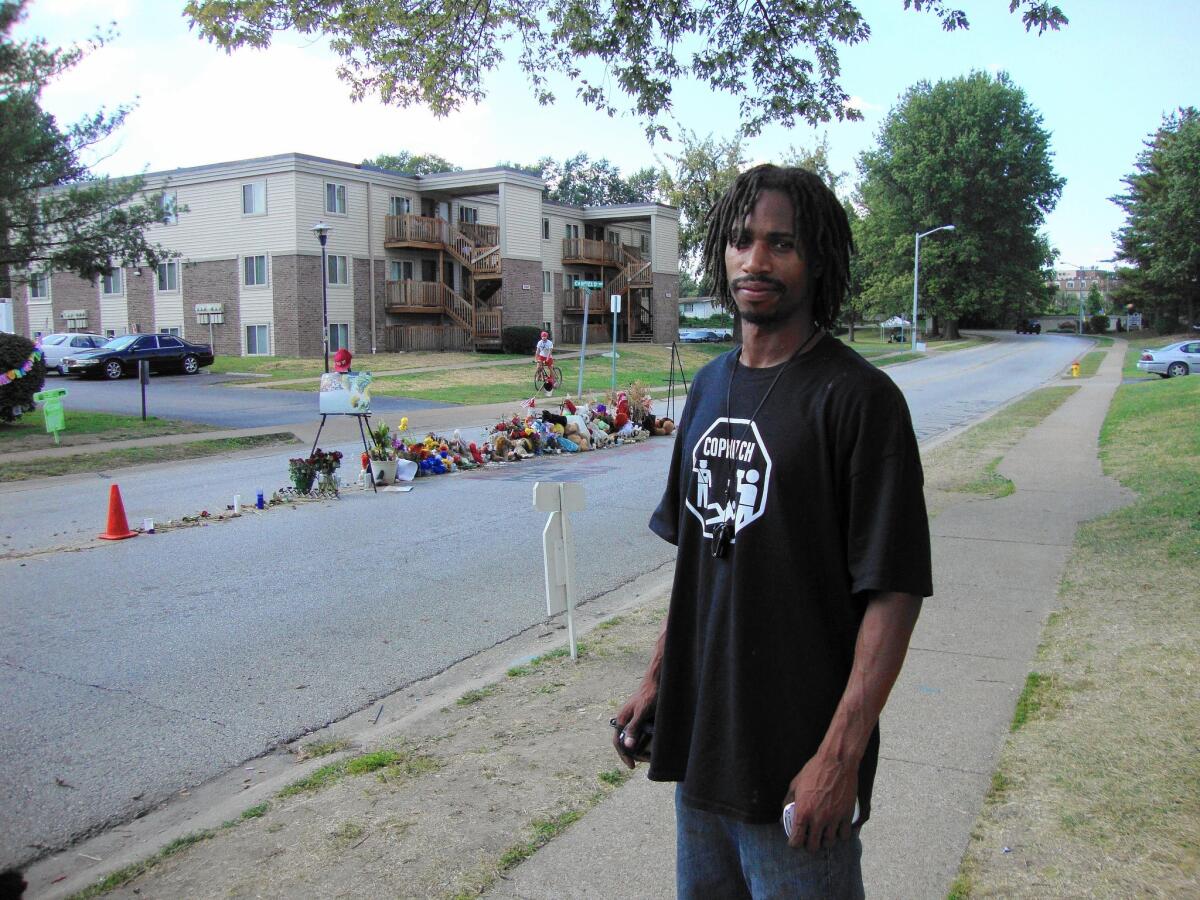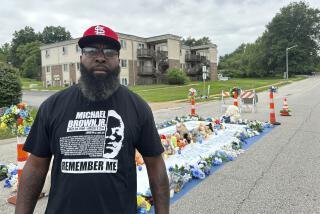In Ferguson, volunteers have electronic eyes on police

- Share via
Reporting from FERGUSON, Mo. — Romana Williams was out patrolling this week with a thumb-size video camera clipped to the collar of her white T-shirt. As the short, gray-haired woman approached the memorials for Michael Brown, the unarmed 18-year-old shot by a local police officer, a Ferguson police SUV drove up.
Williams, 62, had her camera ready.
In the end, the SUV cruised past and there was nothing to record, at least not this time.
The retired tree trimmer is among scores of volunteers in Ferguson now equipped with cameras — not just to watch the neighborhood but to watch police. Williams volunteered because she was upset by Brown’s shooting, and because she has a 23-year-old son with special needs who was jailed during the protests that erupted after Brown’s death.
So far, Copwatch volunteers have raised about $7,600 from nearly 200 donors on gofundme.com to purchase and distribute 110 cameras — and 100 more arrived Monday.
“Now, when the police harass you or target somebody, we can step in and record it,” Williams said.
Much of the conflict in Ferguson, including protesters’ clashes with police last weekend, has been recorded by the media and citizen journalists. They have caught at least one police officer on camera using an assault rifle to threaten a protester; he was suspended.
Some protesters have petitioned for passage of a “Mike Brown Law” that would require police to wear body cameras at all times during their patrols.
Ferguson Police Chief Thomas Jackson recently told the St. Louis Post-Dispatch that his department received 50 donated body cameras, just as Los Angeles police officers and sheriff’s deputies are trying the cameras through pilot programs.
But some activists are skeptical of such cameras. Footage can be tough to obtain and may be incomplete if officers turn their cameras off, as one officer here did last Saturday shortly before he was shot in the arm while pursuing a burglary suspect.
The original Copwatch was started by Berkeley residents in 1990, and has since spread to dozens of cities, including Denver, Los Angeles, New York and Phoenix, driven in part by concerns about increased police brutality.
Copwatch Los Angeles drew national attention in 2006 after a volunteer filmed Los Angeles police punching William Cardenas while arresting him on suspicion of receiving stolen property. An Oakland group, We Copwatch, was started last year by Jacob Crawford, a legal investigator, who traveled to Ferguson after Brown’s shooting to help residents start patrolling the area surrounding the Canfield Green apartment complex where he lived and died.
“Police are less inclined to hurt people when they know they’re being videotaped,” Crawford, 36, told a group of volunteers undergoing training in one of the apartments Sunday. “Keep it with you. It’s your self-defense tool.”
Unlike Neighborhood Watch, where volunteers work with police, Copwatch arms residents with cameras to monitor police and hold them accountable, something many Ferguson residents have demanded since Brown was shot Aug. 9 by Officer Darren Wilson. A grand jury is deliberating whether to charge Wilson.
“We need more Copwatchers, not cops with cameras,” David Whitt, a Copwatch volunteer and recruiter, told fellow volunteers in an instructional video. “We’re going to hold them accountable.”
At the back of the room, Whitt, 34, a thin figure with short dreadlocks, was preparing cameras. Turn them on and a green light glows, he said. That means they’re recording footage that can later be downloaded via a USB port on the side. Each volunteer received a camera before leaving, strung on a lanyard to wear around their necks.
They would also receive tips on when and how to record police. Among the tips: Record yourself saying the time and location of what you shoot. The volunteers also received Copwatch T-shirts featuring the group’s stick figure logo — a police officer, baton raised above a defenseless figure, facing off against a Copwatcher with camera in hand.
Whitt started patrolling with neighbors immediately after Brown’s shooting, before he’d even heard of Copwatch. They called themselves the Canfield Watchmen.
He urged volunteers to record as soon as they spotted officers in the area, and to collect officers’ names. Justice Department officials, who had been investigating Ferguson police, recently compelled them to wear their name tags, which they had been removing or covering with black tape. They also told officers to stop wearing bracelets with the words “I am Darren Wilson.”
“We’ve got to start protecting our neighborhood,” Whitt said, “Because if we don’t, we’re giving the police the authority to come around here. Then what are they going to do? They’re going to mess with everybody.”
Whitt wants to raise money to buy cameras that can stream footage online, and possibly create something else in dire need here: jobs — paid Copwatch patrols.
He told the new recruits that he hopes Copwatch will not only combat police harassment but empower them to deter crime, breaking a code of silence that derides snitches and enables criminals to act with impunity.
“Where’s the accountability in the neighborhood?” he said. “It’s about respecting each other. I’m here to tell you I am not your enemy.”
“That’s right!” shouted one of the recruits, Ricardo Muhammad.
Kris Hermes, a legal observer dispatched to Ferguson from Oakland by the National Lawyers Guild, said Copwatch had already improved conditions at Canfield Green, where few police were sighted this week.
“It’s helped to diminish the police presence in the Canfield area. Maybe that’s a small achievement, but it shows what you can do,” he said, noting, “The police do not always protect and serve there.”
Brian Schellman, a spokesman for the St. Louis County Police Department, which also patrols the Ferguson area, said the department was borrowing body cameras for a pilot program. The agency is aware of Copwatch and not worried, he said.
“There is no concern for us because everyone already has a cellphone with recording capabilities these days, and many people use phones in this capacity,” Schellman said. “We welcome citizens to tape encounters with police. Regardless who is wearing the camera — whether that be police or citizens — cameras will hold everyone involved accountable for their actions.”
Others question investing in cameras.
Missouri state Rep. Jeff Roorda, business manager for the St. Louis Police Officers’ Assn., said St. Louis city police had not benefited from dashboard cameras.
“They lead to targeted enforcement against officers of petty rules, like officers not wearing their hats on calls,” Roorda said.
He said the department was considering spending $2 million on body cameras, which “seems like mislaid priorities in an underpaid department with 14-year-old guns and police cars with over 100,000 miles on them.”
Last Sunday night, John King wore his Copwatch camera to a protest at the Ferguson Police Department.
King, 25, who works at a manufacturing plant, said he volunteered out of solidarity with his neighbors. He tucked the camera inside the neck of his T-shirt as he rode his bicycle in front of the station, then clipped it to his collar for easy access once the crowd grew to several hundred. One protester had painted on the window of a minivan, “Film the police.”
King joined the throng marching to a drumbeat up the street, chanting, “Police accountability now!”
Two dozen local and county police lined up opposite the protesters, some in riot gear. A few people tried to diffuse the tension, to no avail. Officers clashed with protesters, detaining seven.
King was there with his camera, recording it all, “pure, raw truth.”
Twitter: @mollyhf
More to Read
Sign up for Essential California
The most important California stories and recommendations in your inbox every morning.
You may occasionally receive promotional content from the Los Angeles Times.











